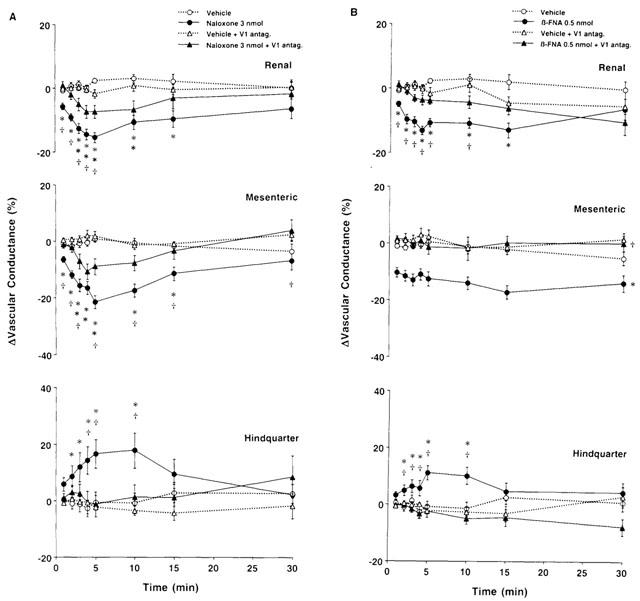Figure 7.

(A) Changes in regional vascular conductances elicited by bilateral microinjection of naloxone – methiodide (3 nmol) or vehicle (aCSF) into the PVN of conscious rats, in the absence (n=12 for both central injections) or presence (n=12 for naloxone – methiodide; n=11 for aCSF) of intravenous treatment with a vasopressin V1-receptor antagonist (10 μg kg−1, i.v. bolus, 10 kg−1 h−1, infusion). (B) Changes in regional vascular conductances elicited by bilateral microinjection of β-FNA (0.5 nmol) or vehicle (aCSF) into the PVN of conscious rats, in the absence (n=15 for both central injections) or presence (n=9 for both central injections) of intravenous treatment with the vasopressin V1-receptor antagonist. Values are means±s.e.mean shown by vertical lines. (A) A significant interaction between treatment and time was found for all calculated cardiovascular variables; (B) A significant interaction between treatment and time was found for ΔRenal and ΔHindquarter Vascular Conductances. *P<0.05 when the cardiovascular responses to naloxone – methiodide or β-FNA in the absence or presence of the vasopressin V1-receptor antagonist are compared with their respective untreated or intravenously treated control (aCSF) group. †P<0.05, when the cardiovascular responses to naloxone – methiodide or β-FNA in the presence of the vasopressin V1-receptor antagonist are compared with those elicited in the absence of the vasopressin V1-receptor antagonist. No significant interaction was observed for ΔMesenteric Vascular Conductance, the comparison between β-FNA and the control (aCSF) (in the absence or presence of the vasopressin V1 receptor antagonist) was done averaging over time.
